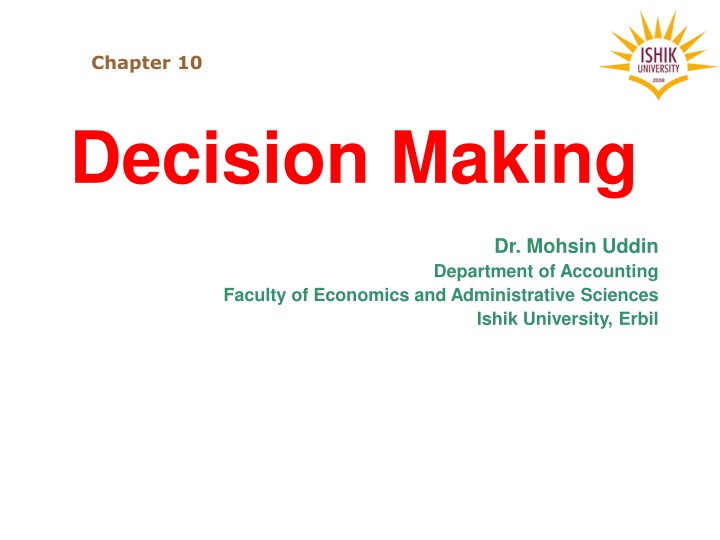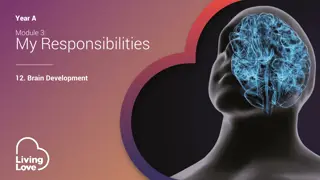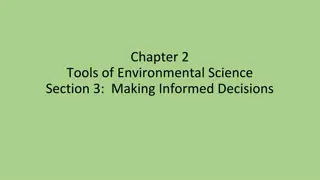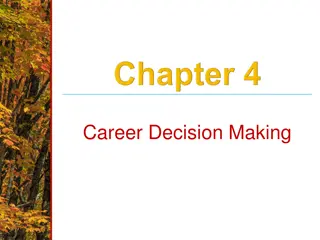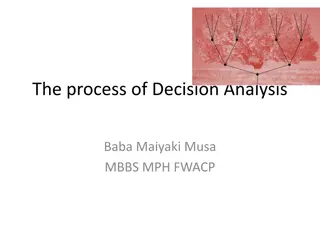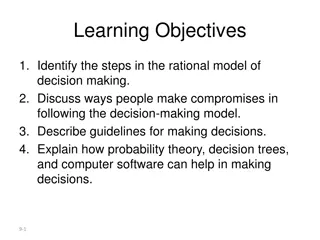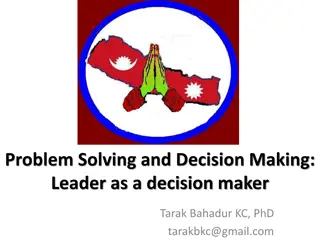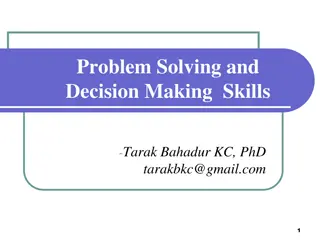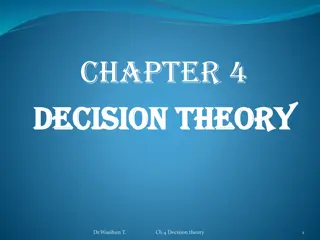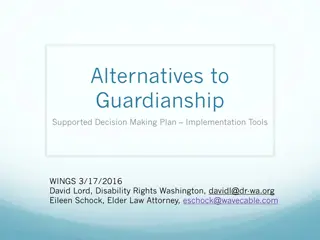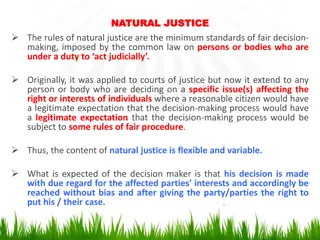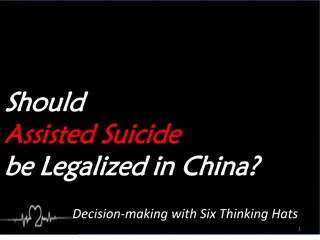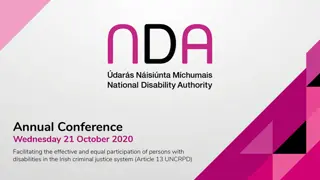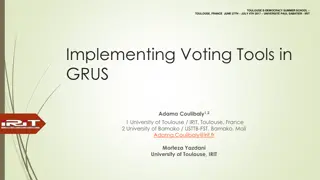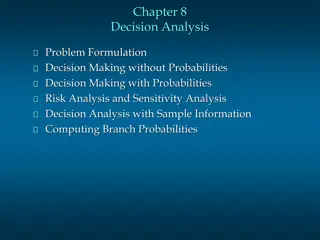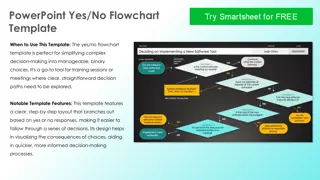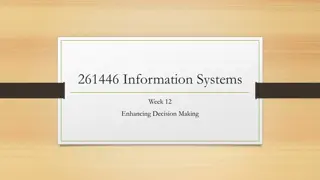Decision Making
Explore the cognitive process of decision-making, its importance, steps involved - from problem identification to alternative selection and implementation. Understand individual differences and guidelines for effective decision-making.
Uploaded on Mar 08, 2025 | 1 Views
Download Presentation

Please find below an Image/Link to download the presentation.
The content on the website is provided AS IS for your information and personal use only. It may not be sold, licensed, or shared on other websites without obtaining consent from the author.If you encounter any issues during the download, it is possible that the publisher has removed the file from their server.
You are allowed to download the files provided on this website for personal or commercial use, subject to the condition that they are used lawfully. All files are the property of their respective owners.
The content on the website is provided AS IS for your information and personal use only. It may not be sold, licensed, or shared on other websites without obtaining consent from the author.
E N D
Presentation Transcript
Chapter 10 Decision Making Dr. Mohsin Uddin Department of Accounting Faculty of Economics and Administrative Sciences Ishik University, Erbil
Learning objectives After going through this chapter, you should be able to: understand the process of decision making; explain the styles of decision making; appreciate the individual differences in decision making; describe the guidelines for effective decision making
Whatis Decision Making? Decisionmaking isthe cognitive process leadingto the selection of acourseof action amongalternatives. Everydecisionmaking processproducesafinal choice. It canbe anaction oranopinion . Examples:Shopping, decidingwhat to eat,What to wear,whento sleep,etc..
Decision-makingProcess 1. Identifying aproblem 2. Identifying decisioncriteria 3. Allocating weights tocriteria 4. Developingalternatives 5. Analyzingalternatives 6. Selecting analternative 7. Implementing thealternative 8. Evaluation (of decisioneffectiveness)
ProblemDefinition Problem is a discrepancy (difference) between an existing and a desired state. Example: Themanagerhasresigned,andweneedanothermanager Here the phrase manager has resigned reflects the current state while needanothermanager representsadesiredstate.
DevelopingAlternatives Involvesdefining the possiblealternatives (orchoices) that would resolve theproblem. Inourcase,thealternatives wouldbealist ofcandidatesorjob applicants. AnalyzingAlternatives Alternativesareratedandanalyzedonthebasisof thecriteria Therating canbebasedonaspecifiedscale,say1 5etc.
Selecting analternative Involveschoosingthebestalternative,basedontheaboverating andanalysis Generallyimplies selectingthealternativewith thehighest score. Implementing theAlternative Puttingthedecisioninto action Involvesclearcommunicationof thedecisionto allconcernedand obtaining theircommitment
Evaluation Evaluationformsanintegral partof anyprocess Involvesevaluationof theoutcomebasedonthe desiredgoaland criteria Involvesassessingtheeffectivenessandefficiencyofthe outcome (or the entireprocess) Incaseofanyundesiredresults,eachstepofthe processis carefullyreviewedto tracetheroot causes
6C'sofDecisionMaking 1. Construct. 2. Compile. 3. Collect. 4. Compare. 5. Consider. 6. Commit.
a clear picture of exactly what must be Construct decided. Compilealist of requirementsthat mustbemet. Collect information on alternatives that meet the requirements. Comparealternativesthat meettherequirements. Consider the what might go wrong factor with each alternative. Committo adecisionandfollow throughwith it.
ProblemAnalysisvs Decision Making It is important to differentiate between problem analysis and decision making. The concepts are completely separate from one another.Problemanalysismust bedonefirst, then the information gatheredinthat processmaybeusedtowardsdecisionmaking.
DecisionMaking Objectives must firstbe established Objectivesmustbeclassifiedandplacedinorderof importance Alternative actionsmustbedeveloped
Thealternativemustbeevaluatedagainstalltheobjectives Thealternativethat isableto achievealltheobjectivesisthe tentativedecision The values tentative decision is evaluated for more possible
Decision-MakingStages Therearefour stagesthat shouldbeinvolvedinallgroupdecision making.Thesestages,or sometimescalledphases,areimportant forthedecision-makingprocessto begin 1. Orientationstage-Thisphaseiswheremembersmeetforthe firsttime andstartto getto knoweachother. 2. Conflict stage- Once group members become familiar with eachother,disputes,little fightsandargumentsoccur.Group memberseventually workit out. 3. Emergencestage-Thegroupbeginsto clearup unclear opinionsbytalking aboutthem. 4. Reinforcementstage-Membersfinally makeadecision,while justifyingthemselves that it wastheright decision.
The D ecsi on m aki ng m odel Classify and define problem or opportunity Set objectivesand criteria Generate creativeand innovativealternative Analyze alternativesand select the mostfeasible Plan andimplement thedecision Control thedecision
1. Defineand diagnosethe problem 2. Setgoals 7. Followup andcontrol 3. Searchfor alternative solutions External and internalEnviron. forces 6.Implement thesolution selected 4. 5.Choose among alternative solutions Compar e and evaluate solution
Decision-Making Styles Reflexive Style Makes quick decisions without taking the time to get all the information that may be needed and without considering all the alternatives. Reflective Style Takes plenty of time to make decisions, gathering considerable information and analyzing several alternatives. Reliable Style Habit of to make decisions without either rushing ( Hurry) or wasting time.
Decision-MakingSteps Wheninanorganizationandfacedwith adifficult decision,thereare several steps one can take to ensure the best possible solutions will be decided. These steps are put into seven effective ways to go aboutthis decisionmakingprocess. The first step - Outline your goal and outcome. This will enable decisionmakersto see exactlywhat theyaretrying to accomplish andkeepthemonaspecificpath. Thesecondstep-Gatherdata.Thiswill helpdecisionmakershave actualevidenceto helpthemcomeupwith asolution. Thethirdstep- Brainstormto developalternatives.Comingupwith more than one solution enables you to see which one can actually work.
Thefourthstep- Listprosandconsofeachalternative.Withthe list of pros and cons, you can eliminate the solutions that have moreconsthanpros,makingyourdecisioneasier. The fifth step - Make the decision. Once you analyze each solution,youshouldpicktheonethat hasmanypros(orthepros that are most significant), and is a solution that everyone can agreewith. Thesixthstep-Immediatelytakeaction.Oncethedecisionis picked,youshouldimplement it right away. The seventh step - Learn from, and reflect on the decision making.Thisstepallowsyouto seewhat youdid right andwrong whencomingup,andputting thedecisionto use.
SWOTAnalysisStrategicUse OrientingSWOT stoAnObjective-IfSWOTanalysisdoesnot start with defining a desired end state or objective, it runs the risk of beinguseless. Ifaclearobjectivehasbeenidentified,SWOTanalysiscanbeused to helpinthepursuitof that objective. Inthiscase,SWOT sare: Strengths Attributes of the organization that arehelpful to achieving theobjective. Weaknesses Attributes of the organization that are harmful toachieving the objective. Threats External conditions thatare harmful toachieving the objective. Opportunities External conditions thatare helpful toachieving the objective.
SWOTAnalysisCreativeUse Creative Use of SWOT s If the objective seems attainable, the SWOT s are used as inputs to the creative generation of possible strategies,byasking(usuallyingroups)andansweringeachof the followingfourquestions,manytimes: Strengths Weaknesses HowcanweStop eachWeakness? Howcanweuseeach Strength? Opportunities How can weExploit eachOpportunity? Threats How can weDefend against eachThreat?
GroupDecision-making Thefactorsrequiring groupdecisionsinclude: 1. Involving sensitiveissues 2. High costalternatives 3. Involvingveryhighriskfactor 4. Strategicimpact
Group Decisions:Advantages 1. Acceptance of groupmembers 2. Coordination iseasier 3. Communication iseasier 4. Existence of largealternatives 5. More informationcan be processed 6. Diversity ofexperience and perspectives
Group Decisions:Disadvantages 1. Take longertime 2. Group can beindecisive(open) 3. Groups cancompromise 4. Groups can bedominated 5. Groupscan playgames
SituationalFactorsforGroupDecision Making Risk taking solutionneeded Datacollection Betterunderstanding Importance ofacceptance Whole responsibility Importance of solution Feedbackrequired Complex problem Democraticprocess MakingNeedforinnovationand creativity
Improving GroupDecision- MakingBrainstorming Nominal grouptechniques Electronicmeeting
Identify six decisions that you have taken during last one year. Check which decisions were made under certainty, under risk and under uncertainty. Decisions 1. 2. 3. 4. 5. 6. Certainty Risk Uncertainty (Confidence)
Successfulleadershavethecourageto takeactionwhile othershesitate. -JohnC.Maxwell
BarrierstoGoodDecisionMaking 1. Quick-Makingquickdecisionswithout havingmuch thought. 2. Narrow-Decisionmakingisbasedonverylimited information. 3. Scattered-Ourthoughtsinmakingdecisionsare disconnected ordisorganized. 4. Uncertain-Sometimes,thelackof clarityon important aspects of a decision causes us to overlook certain importantconsiderations.
